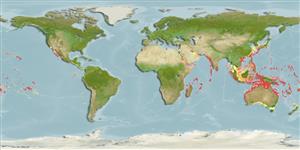Common names from other countries
Environment: milieu / climate zone / depth range / distribution range
Ecologie
; diepteverspreiding 11 - 62 m (Ref. 3099). Tropical
Indo-Pacific.
Length at first maturity / Size / Gewicht / Leeftijd
Maturity: Lm ? range ? - ? cm Max length : 9 cm TL (female)
Minimum depth from Ref. 80410. Intertidal to subtidal (Ref. 106854). Inhabits sandy bays (Ref. 3533); shallow waters in sand flats, seagrass beds with coral rubble substrate (Ref. 80538) and also in reef flats or tidal flats under rock or boulders or inside rock crevices (Ref. 87055). Stomatopods are predators that require living prey (Ref. 833).
Life cycle and mating behavior
Geslachtsrijpheid | Voortplanting | Kuitschieten | Eieren | Fecundity | Larven
Some members of the order Stomatopoda pair for life and some come together only to mate. Males produce sperm ducts rather than spermatophores; females can brood a maximum of 50,000 eggs. Life cycle: Eggs hatch to a planktonic zoea which lasts for 3 months.
Ahyong, S.T. 2001. (Ref. 3099)
Status op de Rode Lijst van het IUCN (Ref. 130435)
Status bij CITES (Ref. 108899)
Not Evaluated
Not Evaluated
Gevaarlijk voor mensen
Harmless
Gebruik door de mens
| FishSource |
Tools
Meer informatie
Leeftijd/GrootteGroeiLengte-gewicht parametersLengte-lengte parametersMorfologieLarvenAbundantie
Internet-bronnen
Estimates based on models
Preferred temperature
(Ref.
115969): 24.3 - 29, mean 27.8 (based on 912 cells).
